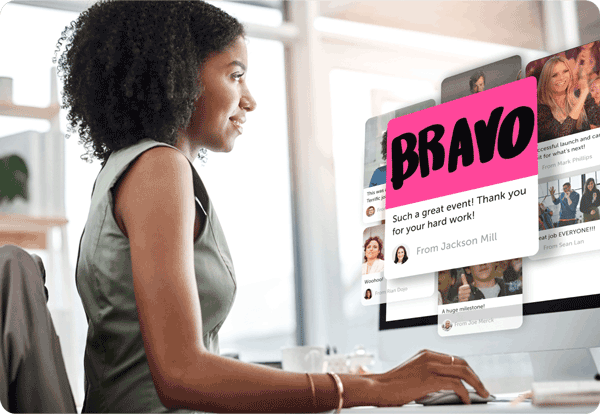
It’s 2025 and the importance of employee recognition is not changing in the workplace. In a 2 year study by Gallup and Workhuman, research showed that well-recognized employees are 45% less likely to have turned over after two years.
Not only do employees benefit from being recognized, but companies also benefit from great recognition tactics. Employee turnover costs companies real money, as they have to pay to recruit, hire, and train a new employee. It can often be more cost effective for the companies to treat the employees they have well and keep them for the long haul!
The Link Between Recognition and Retention
Employee recognition is the act of recognizing an employee for their behavior, accomplishments, or efforts in the workplace. A common misconception is that each act of recognition has to be a grand gesture, but that is not true. Valuable and genuine recognition is often found in the everyday gesture of saying thank you, leaving a note, or giving a simple shout out in a team meeting. These small acts of recognition can be invaluable in keeping your employees happy and feeling valued in the workplace.
We all feel the innate need to be recognized for our efforts. (We aren’t robots after all!) Research at the Maven Clinic found that “Employee recognition directly addresses a range of these needs including respect, self-esteem, status, recognition, and a sense of connection.” When employees are recognized for their efforts, even in small ways, they are more likely to stay at the company and keep working hard.
Employee Recognition Data
If you’re still not convinced (or your boss isn’t), recent studies show how critical employee recognition is to a thriving company culture, and the correlation between recognition and retention.
Researchers found:
- Employees who feel recognized are 2.5 times more likely to be happy with their jobs and 1.5 times more likely to feel motivated to do their best. (Gallup)
- 78% of respondents believed that employee recognition positively impacted employee retention. (HBR Survey)
- Happier workers are 13% more productive at work. (Oxford University)
Based on this data, it is clear how important employee recognition is and why companies should make that their focus in 2025 to help with employee engagement, reduce turnover, and create a culture of recognition in the office.
Employee Recognition Trends for 2025
Employee recognition is not a new term in the business world. However, there are a few important trends that companies need to watch out for in 2025 that will affect how employee recognition is done in the office.
Hybrid and Remote Work Challenges
Many companies are still leaning into hybrid options for employees. A hybrid schedule has many benefits like less time commuting, a better work/home balance, and more flexible schedules.
However, there are also downsides to hybrid or remote work. For example, some employees have felt isolated in a hybrid or remote work setting. Another problem with hybrid or remote employees is that there is a lack of visibility.If the employee isn’t in the office, it can be hard to know what they need, what they’re working on, or even remember when to offer recognition.
A study by the Society for Human Resource Management (SHRM) revealed that 41% of remote workers feel disconnected from their organization’s culture, making them more prone to disengagement.
How can employers help to combat disengagement and isolation with hybrid/remote employees? A lot of these feelings can be solved with employee recognition. When the organization takes time during the week to recognize employees’ efforts, it makes a difference. Recognition also takes effort and shows that leaders are interested in what the employee is working on, which can increase engagement.
5 Ways Employers Can Recognize Hybrid and Remote Employees
- Virtual Shout-Outs in Team Meetings
- Acknowledge accomplishments during virtual team meetings or all-hands calls.
- Example: “Let’s give a big shout-out to Sarah for her exceptional work on the project this week. Her creativity really made a difference!”
- Personalized Digital Recognition
- Leverage recognition platforms like Kudoboard to send personalized messages, digital badges, or gift cards.
- Ensure the message is specific to the employee’s achievements and ties back to company values.
- Example: Create a Kudoboard with team comments for a remote employee’s work anniversary.
- Send Thoughtful Gifts or Care Packages
- Surprise remote employees with small tokens of appreciation, such as gift cards, branded merchandise, or snack boxes.
- Example: After a major project milestone, send a coffee gift card with a note saying, “Take a moment to celebrate—you’ve earned it!”
- Organize Virtual Celebrations
- Host virtual events like happy hours, trivia games, or online team-building activities to celebrate milestones or achievements.
- Example: Celebrate an employee’s work anniversary by inviting their team to share funny or inspiring memories in a virtual event.
- Provide Career Growth Opportunities as Recognition
- Recognize excellent performance by offering career development perks, such as online course reimbursements, access to mentorship programs, or a stretch assignment.
- Example: Reward a remote employee’s exceptional performance by enrolling them in a leadership development program.
Tip: Pair these recognition efforts with public appreciation on company channels like newsletters, intranet, or Slack/Teams to maximize their impact.
Gen Z Preferences: The Role of Employee Recognition in Shaping Their Workplace

Flexibility, Tech Integration, and Recognition
Gen Z brings fresh expectations to the workplace, demanding not only flexibility and seamless tech integration but also consistent and meaningful recognition. This digital-native generation expects organizations to leverage technology for more than just efficiency—they want it to foster connection and acknowledgment. Platforms like Slack, Microsoft Teams, and Kudoboard are avenues for real-time, public recognition that help Gen Z employees feel seen and valued.
Flexibility is non-negotiable for Gen Z, with over 60% citing it as a top priority, according to a 2025 SG Analytics report. Yet, flexibility without recognition can leave employees feeling invisible. By pairing flexible work arrangements with regular, tech-enabled recognition, employers can ensure their contributions aren’t overlooked. For instance, a simple “Great job!” on a collaborative platform or a personalized shout-out in a virtual meeting can go a long way in motivating and retaining Gen Z workers.
Mentorship, Collaboration, and the Power of Recognition
While Gen Z appreciates the autonomy of hybrid work, many are actively returning to office spaces in search of mentorship, collaboration, and a deeper sense of belonging. According to the New York State Society of CPAs, Gen Z values face-to-face interactions for personalized guidance and professional growth. Integrating recognition into these interactions—such as celebrating progress in a mentorship meeting or highlighting contributions during collaborative sessions—reinforces their sense of purpose and importance within the organization.
Collaboration is also enhanced when recognition is woven into the culture. Gen Z employees are more likely to engage and innovate when their ideas and efforts are openly celebrated. These moments of acknowledgment not only boost individual morale but also strengthen team cohesion, fostering an environment where creativity and trust flourish.
By embedding recognition into every aspect of work—whether it’s through flexible arrangements, technology, or personal mentorship—organizations can meet the unique needs of Gen Z. This generation doesn’t just want a job; they want to feel valued, appreciated, and connected to a mission, making employee recognition a cornerstone of their workplace satisfaction and retention.
The Financial Impacts of Employee Recognition
Employee retention is a financial priority in 2025, as high turnover costs continue to strain organizations. Replacing an employee can cost 50% to 200% of their annual salary, factoring in recruitment, onboarding, and lost productivity. Even worse, executive-level turnover can cost up to 300% of annual pay.
Turnover also disrupts productivity, with new hires taking up to 12 months to reach full efficiency, and overburdened teams risk burnout and disengagement. Disengaged employees alone cost companies 18% of their annual salary in lost productivity.
Retention improves customer satisfaction, as experienced employees foster stronger customer relationships. Bain & Company found that a 5% increase in employee retention boosts customer retention by 25% to 95%, directly impacting revenue.
Investing in recognition programs is a cost-effective retention strategy. Companies with strong recognition efforts see a 31% reduction in turnover and a 12% rise in productivity, making employee recognition essential for financial health and workforce stability in 2025.
Beyond Retention: Additional Benefits of Employee Recognition

Employee recognition doesn’t just affect retention, there are several other benefits that companies can see with proper employee recognition tactics.
Enhanced Productivity and Performance
Recognition boosts motivation and accountability by reinforcing desired behaviors. Employees who feel valued are more engaged and productive. Gallup reports that employees receiving frequent recognition are 4.6 times more likely to feel engaged, driving overall team performance.
Improved Workplace Culture
A culture of recognition fosters positivity and inclusivity. Acknowledging contributions at all levels helps employees feel valued and strengthens team cohesion. SHRM found that organizations with strong recognition programs experience 31% lower turnover and 41% higher satisfaction.
Strengthened Employer Brand
Recognition enhances an organization’s reputation, making it more attractive to top talent. Employees who feel appreciated share positive experiences, boosting the employer brand. LinkedIn data shows companies with strong brands attract 50% more qualified applicants and reduce hiring costs by 28%.
Implementing Recognition Programs in 2025
A great way to improve employee recognition is to implement an employee recognition program. Implementing an effective recognition program requires thoughtful design, a commitment to authenticity, and ongoing evaluation. By addressing employee needs, avoiding common pitfalls, and leveraging the right tools, organizations can create a recognition culture that not only improves retention but also drives long-term success in 2025 and beyond.
Steps to Build a Recognition Program
- Assess Current Gaps
- Conduct employee surveys or focus groups to understand how recognition is perceived and identify areas of improvement.
- Review current recognition practices to determine what works, what doesn’t, and where there are gaps (e.g., recognition frequency, inclusivity, or alignment with company values).
- Design a Program Aligned with Employee Needs and Company Goals
- Set Clear Objectives: Define what the program aims to achieve, such as improving retention, boosting morale, or reinforcing specific behaviors.
- Tailor to Employee Preferences: Consider diverse employee needs, such as public vs. private recognition, monetary rewards, or development opportunities.
- Integrate Core Values: Align recognition with organizational values to make it meaningful and reinforce desired cultural behaviors. For example, if collaboration is a core value, design awards around teamwork achievements.
- Choose the Right Tools: Invest in platforms like Kudoboard or Slack integrations that make recognition easy, scalable, and inclusive, even for hybrid or remote teams.
Avoiding Common Pitfalls
When introducing a new recognition program, it is vital to avoid common pitfalls. Here are a few that companies might encounter.
- Generic or Insincere Recognition
- Avoid generic phrases like “good job” that lack specificity. Instead, acknowledge specific contributions or achievements. (e.g., “Your creativity in designing the new client proposal secured the deal.”)
- Ensure recognition feels authentic by tailoring it to the individual. For instance, introverted employees may prefer private praise, while extroverts may thrive on public acknowledgment.
- Inconsistent Recognition
- Employees quickly notice if recognition is sporadic or favors certain individuals. Establish clear guidelines to ensure consistency across teams and levels.
- Train managers to recognize contributions regularly and fairly, ensuring all employees feel valued.
- Ignoring Non-Monetary Recognition
- While bonuses and gifts are appreciated, non-monetary recognition—such as verbal praise, certificates, or development opportunities—can be equally impactful and more sustainable.
Measuring Program Success
With any recognition program, the program’s success has to be monitored to ensure it is operating efficiently and working for everyone.
- Define Success Metrics
- Track retention rates, employee engagement scores, and productivity metrics pre- and post-implementation of the recognition program.
- Use employee feedback to assess whether recognition efforts feel authentic and meaningful.
- Leverage Tools for Tracking and Feedback
- Utilize the analytics in your chosen software to track participation, frequency, and the impact of recognition activities.
- Conduct regular surveys or pulse checks to gather employee insights on the program’s effectiveness and areas for improvement.
- Evaluate ROI
- Compare the cost of the recognition program against the savings from reduced turnover and increased productivity. For example, calculate the reduction in hiring and onboarding costs and correlate it with improved retention rates.
- Share success stories and results with leadership to secure ongoing support for the program.
Recognition: The Key to Retaining Top Talent and Unlocking Success in 2025
In 2025, employee recognition has emerged as a pivotal factor in reducing turnover, driving employee engagement, and maximizing organizational success. As we’ve highlighted, recognition not only fosters a sense of value and belonging among employees but also directly influences retention by making employees feel appreciated and motivated. The financial benefits are clear: investing in recognition programs can significantly reduce turnover costs. Beyond retention, recognition also boosts productivity, cultivates a positive workplace culture, and strengthens a company’s employer brand—leading to a more engaged, loyal workforce.
As companies navigate the evolving workforce landscape in 2025, it’s crucial to view employee recognition as a strategic investment rather than a perk. Business leaders should take action now—implementing recognition programs that meet the diverse needs of their teams will yield long-term benefits, including higher retention, improved morale, and a competitive edge in the talent market.
As we move into an era where talent is a company’s greatest asset, investing in employee recognition is no longer optional—it’s a fundamental strategy for the future of work.




